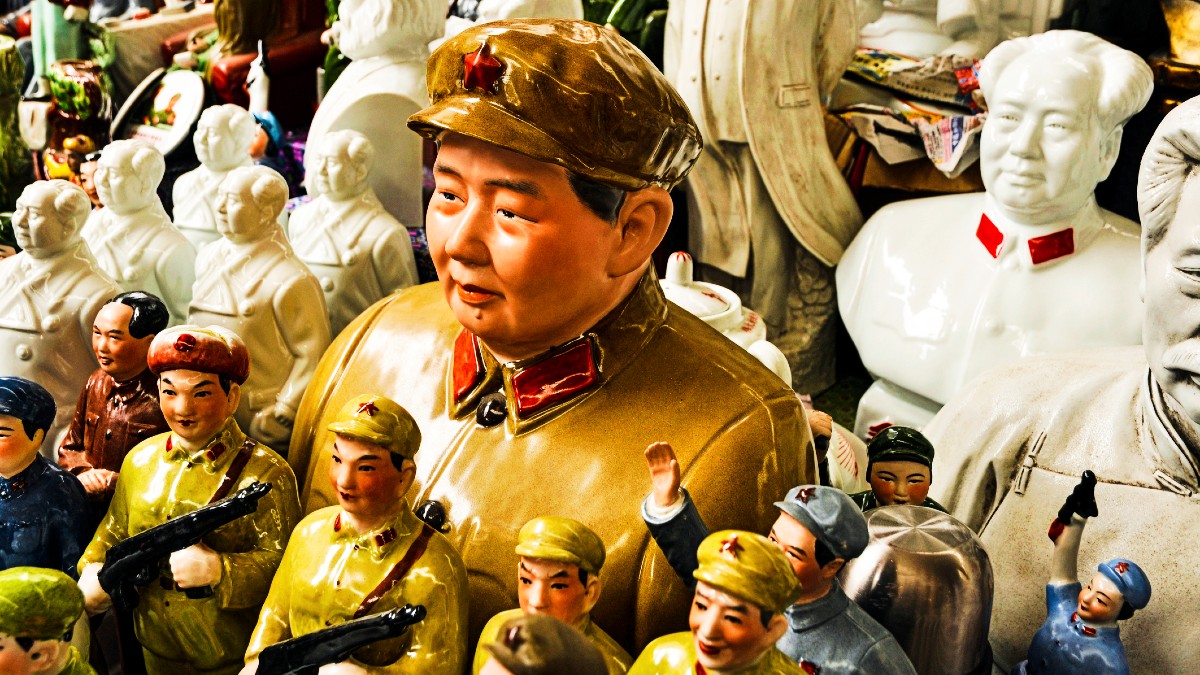A Chinese EV maker ended its Wall Street debut circa 33% higher on Friday.
Just where Geely Group’s Zeekr closes this Friday in New York will say much about everything which is about to unfold over the next fun-filled few days.
This is the week, for example, where China will simply just stop telling us how much offshore money is coming in or out of its bloodied stockmarkets.
China’s key mainland indices – the Shanghai and Shenzhen exchanges – will now disclose trading via links with the Hang Seng in Hong Kong once daily. It sounds suss, ok, but a tattered global reputation won’t matter if home team sentiment gets the ball rolling.
Then the overseas money will return.
The decision to cancel real-time info on foreign flows in faltering Chinese stocks was made back in April and was an easy call considering what the spectacle of evaporating OS investment was doing for the mental health of the remaining market participants.
China is set to switch off a live feed of foreign flows for stocks as early as Monday, the latest policy move to shore up confidence by removing a potential source of negative data. https://t.co/XLD0QlVVEV
— Nathan Attrill (@nathanattrill) May 12, 2024
Overseas funds have been pulling their dosh out of China with increasing intensity for the about a year now.
Are Chinese shares in a new bull market?
Only Chinese markets – and this week will be a veritable sliding doors moment for the three majors – have pretty much turned things around since the latest regulatory tweak was announced in April.
At their February low, Chinese shares had fallen 45% from their 2021 high on the back of worries about the Chinese property market and economy and this left them very undervalued trading on a PE of around x10 and under-loved.
Since then, mainland stocks have rebounded circa 15%. The Hang Seng Index has found almost 7% in May alone as the securities regulator told media it’d move on expanding the links with mainland exchanges and lift the quality of listings, however that might be achieved.
In any case Hong Kong benchmark hit eight-month highs on Friday.
High divvy-paying stocks surged on other regulatory talk, this time targeting the onerous dividend tax mainland investors pay on Hong Kong-listed shares, which amounts to 20%.
The Hang Seng ended Friday more than 2% its third straight weekly win and spent the weekend at its loftiest vantage since the beginning of August last year.
Optimism is growing that China’s recovery will gather further pace after two key cities of Hangzhou and Xian scrapped all restrictions on home purchases, and both imports and exports beat projections last month.
Hong Kong property stocks will be among the key beneficiaries if China regulators waive dividend tax for mainland retail investors.
The upshot? Property giants Shimao Group lifted 57% and China South City 45%.
Meanwhile, on Saturday morning as the rain again fell on Sydenham, shares in the high-end brand Zeekr jumped by more than third in what was the biggest IPO in the States by a Chinese company since 2021.
That was either great timing, or the prelude to a stellar burn out. This week will settle the matter, according to what we’re reading.
Biden v China.
We’re seeing lots and lots of reports that US President Joe Biden will soon announce massive new tariffs on China, targeting imports like electric vehicles, solar cells and batteries.
Bloomberg and Reuters both reckon the Biden administration plans to raise tariffs on Chinese electric vehicle imports from 25% to 100%.
This is partly political with Trump threatening a 60% tariff on all Chinese imports already, and the shoe fits for Biden, who has been intensifying his efforts ahead of the US election to protect American industry.
But to watch Zeekr jump 34% shows what can happen when a Chinese EV maker taps into US markets for funding.
The Hangzhou-based premium EV brand, split from the mothership of China’s giant carmaker Geely Group, raised well over US$440mn with stocks priced at $18 and closing at over $28.
However, the improving investor sentiment towards Chinese-linked EV stocks may be short-lived, so the following numbers will be ones to watch as the year unfolds.
The China Association of Automobile Manufacturers (CAAM) reported over the weekend that vehicle sales jumped 10.2% during the first four months of the year.
While new energy sales surged 32.3%.
A separate report from the China Passenger Car Association (CPCA) indicated that new energy vehicle sales accounted for 43.5% of total car sales in April, the highest share on record.
That might be the best news from either the CAAM or the CPCA for a while. As mentioned, there could be some painfully sharp export levies out of the States this week.
And with numbers like that, no wonder it’s an easy sell for US politicians to say China’s just flooding US (and global) markets with cheap EVs, threatening jobs, big-ass trucks and the great US car industry.
China Tech Earnings: x2 to the contrary (Alibaba + Tencent)
Despite facing a challenging regulatory landscape in China, Tencent Holdings and Alibaba Group are poised to showcase their resilience in their upcoming earnings reports this Tuesday in the States, says eToro’s Josh Gilbert from Sydney.
“The Chinese government’s shift towards supporting overseas listings and funding for tech firms marks a turning point, reflected in the companies’ increased share buybacks to boost shareholder returns.”
Alibaba’s anticipated modest growth in the last quarter amidst domestic e-commerce market headwinds and slower cloud business expansion.
Despite these challenges, Josh reckons both tech giants present “attractive valuations for contrarian investors” amid their recent struggles.
“Looking ahead, Alibaba’s strategic vision under CEO Eddie Wu to evolve into an open tech platform for AI innovation across various industries offers a glimmer of hope.”
Similarly, Josh says Tencent’s global launch of TanLIVE, a climate community platform aimed at promoting carbon neutrality, signifies a proactive stance amidst industry shifts.
“With lower valuations and rising earnings expectations, a strong performance in the upcoming earnings reports could provide much-needed momentum for these tech giants in the market.”
CPI up, PPI down: tough call for PBoC
Lots of useful data dropped over the weekend, some of good, most of it mixed.
China’s annual inflation rate rose to 0.3% in April 2024, compared with market estimates and March’s figure of a 0.1%. In other data, PPI’s drop was worse than expected, while CPI rose. The data may prompt the PBOC to fiddle with the cost of money.
It was the third straight month of consumer inflation, amid ongoing recovery in domestic demand despite a fragile economic revival.
Core consumer prices, which strip out volatile food and energy prices, increased by 0.7% y-o-y in April, compared with a 0.6% rise in March. Monthly, the CPI increased by 0.1%, a reversal from a 1.0% fall in March which was the steepest decline in three years.
China’s producer prices slid by 2.5% yoy in April 2024, compared with market forecasts of a 2.3% fall and following the 2.8% decrease of March.
Ladies and gents, that’s the 19th month in a row of contracting factory-gate prices highlighting how little the current swathe of government-led support measures can do in the face of persistent economic uncertainty.
And China’s servings of new credit retreated for the first time in April with aggregate financing down sharply by almost 200bn RMB (US$27.5bn) from March.
Chinese banks dolled out some 0.73 trillion in new RMB loans in April, falling precipitously from 3.1trn rmb in March and rather badly missing market estimates of 1.2trn RMB.
April is traditionally an ordinary month for new credit despite this year arriving with a new re-lending tool from the People’s Bank of China (PBoC). Even so the new number was the littlest since July 2023.
Still, faced with the unresolved, slo-mo collapse of the country’s enormous property sector as well as diminishing returns on infrastructure, no-one can accuse Beijing of sitting on its hands; a cracking write-up in the Lowy this week details how Beijing’s made a concerted decision to shepherd low-cost capital into its manufacturing sector.
According to the Lowy, loans flooded back into old reliable manufacturing since the dramas all began around the time everyone started coughing in Wuhan. When lending was around US$111 billion in Q1 2020 to a reported US$695 billion in Q3 last year.
Since the start of the year, the PBoC has handed out a total of CNY 10.19 trillion in new loans.
Special bonds = special liquidity boost
Finally, also kicking off this week, China has started sounding out brokers on how best to flog 1trn RMB (circa US$140bn) of special sovereign bonds, in a semi-stimulatory move which should improve liquidity in the bond market for longer-dated Chinese bonds, which investors have historically tended to hold to maturity, in a further bulwark for the economy.
Beijing has form on these kinds of similar, highly-targeted long-dated bonds.
Back in in 2020 the central government brains trust quickly rolled out the same numbers 1trn RMB vs Covid-19 pandemic and to stimulate infrastructure spend.
As per the FT, this is the fourth round of special sovereign bond issuance, after a sale in 1998 to recapitalise state banks and 2007 to set up its sovereign wealth fund.
These bonds go longer – funding long-term projects while alleviating the debt burden of local governments.
China would also like to shift its economy away from a growth model fuelled by investment in property and infrastructure, which has caused the debts held by local governments to balloon.
Bounce or bull?
For now it’s too early to tell if it’s just a bounce or the start of a new bull market, according to AMP head of investment strategy and chief economist Shane Oliver.
“But there are some positives supporting the case for more upside,” he concedes.
“While Chinese policy stimulus has been light on, the economy has been better than feared defying forecasts of a property driven collapse.
“And the strength in copper prices and the pick-up in iron ore since its April low are providing some positive confirmation of possibly better conditions in China.
“If it does have further to go – its a positive for for resources shares, which is a positive for the Aussie dollar – or vice versa.”
The post Is there finally a bull in the China shop? appeared first on Stockhead.






















